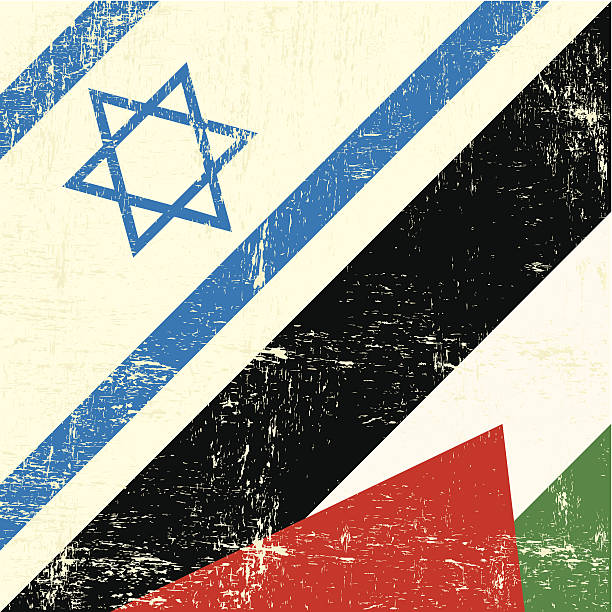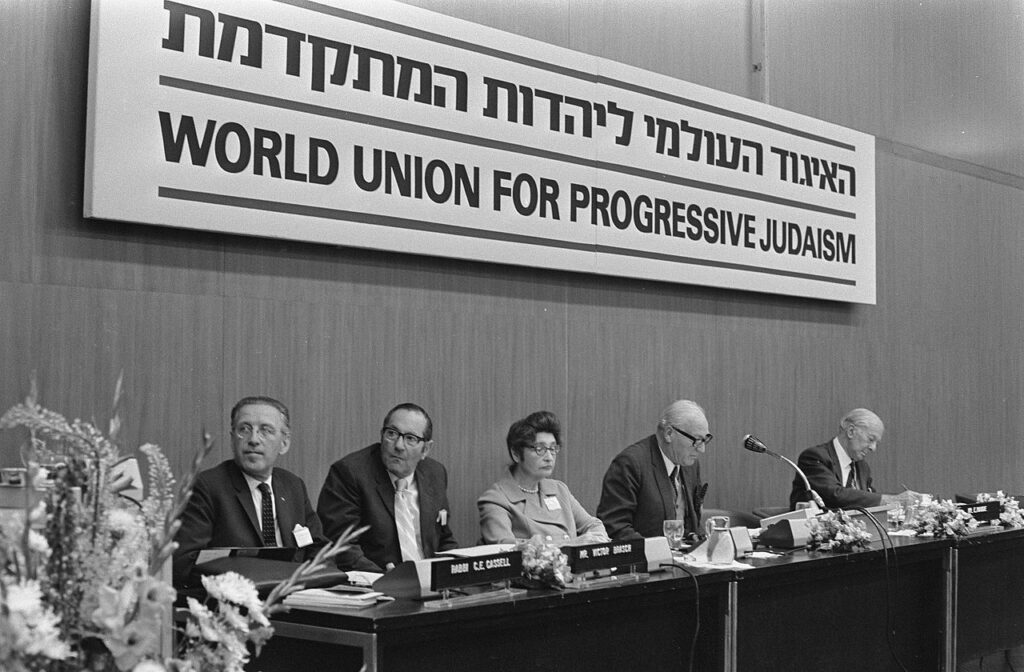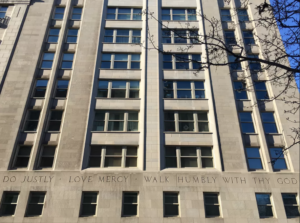Prophetic Except for Palestine: On Social Justice and Reform Judaism
Reform Judaism promotes social justice activism in the United States, but stays mostly silent on Israel's treatment of Palestinians

(Israel and Palestine flags. Image source: iStock)
During most of my childhood in the 1970s and 80s, my father, a Reform rabbi, worked at the Reform movement’s New York headquarters, reporting to a building that displayed the movement’s mid-century motto to the passing world: “Do Justly. Love Mercy. Walk Humbly with Thy God.”
Carved in stone in the early 1950s, these words from Micah 6:8 were intended both as a timely assertion of Reform Judaism’s support for the emergent Civil Rights movement, and as an indelible testament to Reform Judaism’s elevation of social justice-oriented worldly values over traditional Jewish rituals.
Reform Judaism was at that point a new tradition, having emerged in Germany around 1800 in response to myriad internal and external pressures to demonstrate Judaism’s capacity for modern survival. Jewish continuity, in the minds of the Reformers, required an emphasis on the prophetic tradition, now reframed in quintessentially nineteenth-century terms as the Jewish people’s gift to the world. Historian Michael A. Meyer writes that, for the early Reform leaders, the biblical prophets became “the most viable and important component of Judaism. The Prophets’ concern for the poor and downtrodden, their contempt for ritual acts unaccompanied by social morality, and their vision of peace for all humanity—these made Amos, Isiah, Micah, and the others both timeless and contemporary.”
The Reform movement initially aimed to reshape all of Judaism in this modified prophetic image, but, facing resistance from more traditionalist community members, began to coalesce instead as a distinct denomination in the 1840s. The Union of American Hebrew Congregations (UAHC), its North American governing body now known as the Union for Reform Judaism (URJ), was established in 1873.
The “Do Justly” inscription is emblematic of the prophetic tradition promoted by Rabbi Maurice Eisendrath, the UAHC’s first President, who served from 1946 to 1973. As he wrote in 1956: “be it noted that in this exalted summation, ‘to do justly’ precedes even the command ‘to walk humbly before God.’”
However, by the time I had those words memorized as an under-supervised five-year-old tearing around my dad’s office, they were already becoming something of a relic of an earlier era. With the dissolution of the Civil Rights coalition, as Eisendrath himself commented in 1973, “Jewish out-reach ha[d] twisted—snail-like—around into itself.” With that inward turn, the organizational energy and moral urgency that had been directed to equal rights for people of color in the United States shifted toward the protection of a Jewish majority in Israel instead.
***
Reform Judaism’s support for Zionism was never a foregone conclusion. In its earliest days, the Reform movement specifically defined itself against Zionism as counter to its goal of peaceful coexistence with the non-Jewish world. As Meyer documents, a representative group of Reformers in Germany offered as one of their three guiding principles that, “We neither expect nor desire a messiah who is to lead the Israelites back to the land of Palestine; we recognize no fatherland other than that to which we belong by birth or civil status.”
For good if not great reasons, in the aftermath of World War II and the Jewish Holocaust, Zionism came to be accepted as a tool for Jewish self-defense, although neither universally nor instantaneously. Some groups such as the Satmar Hasidim and the Reform-founded (and subsequently Reform disavowed) American Council for Judaism, maintain a position of religious anti-Zionism today. Others more subtly declined and still decline to reorient their Judaism toward a new country in the Middle East.

(1970 meeting of the World Union for Progressive Judaism. Image source: Dutch National Archives)
Today’s Reform establishment rarely acknowledges such heterogeneity. For example, my mainstream neighborhood Reform synagogue so completely assumes a Zionist consensus that it has in recent years distributed pledge cards in support of AIPAC (the influential pro-Israel lobby group) at High Holiday services, and led its religious school students in solemn renditions of “Hatikvah” (the Israeli national anthem). Synagogue leaders react with shock on the rare occasions when such actions are contested. Why are we at synagogue if not to praise Israel?
Less acknowledged still is the extent to which Zionism has replaced prophetic action as the agreed-upon cornerstone of Jewish survival. In the absence of any other articles of faith (a topic on which Reform Judaism is famously flexible), the religious work of Reform Judaism—its task of transmitting belief beyond reason—appears to have narrowed to the single endeavor of insulating the state of Israel from the claims of universal justice that were at one time the movement’s main focus.
As the Jewish denomination with the largest North American membership and among the smallest footprints in terms of numbers and influence within the state of Israel, Reform Judaism has solid moral and historical reasons for resisting Israel’s claims to Jewish exemplarity. Prophetic Reform Judaism would lose little, religiously speaking, by acknowledging the Palestinian people as among the “poor and downtrodden” and in need of immediate relief that diaspora Jews are well-positioned to provide.
Indeed, some mid-century Reform leaders, including Eisendrath (1902-1973) and Albert Vorspan (1924-2019), were, although self-identified Zionists, sufficiently rooted in the prophetic tradition to grapple publicly with the contrast between the utopian hope for Jewish safety that Zionism represented and the brutal reality of its execution on lands already inhabited by Palestinians.
In a 1970 essay excoriating American Jews for their unwillingness to criticize Israel’s actions, Eisendrath praised Israeli critics of Israeli policy for having the courage to ask “what will it profit us Jews if the State of Israel survive and Judaism lie dead on the field of battle [?]” In a similar vein, Vorspan, UAHC Vice President and social justice strategist from the 1950s to the early 1990s, published a still well-known 1988 essay wrestling with Israel’s brutal tactics for suppressing the first Palestinian Intifada, commenting that, “The moral equation has changed. Whether we accept it or not, every night’s television news confirms it: Israelis now seem the oppressors, Palestinians the victims.”
Such frank moral reckoning is in short supply today. Reform Judaism is coming increasingly to resemble contemporary Israel in its devotion to purifying its own ranks of dissent or doubt. In 2018, Israel drew international condemnation with the passage of its Nation-State Law, which defines the “right to national self-determination” within the state of Israel as “unique to the Jewish people” (and thus legally inaccessible to Palestinians). That same year, the URJ issued an official statement claiming “the Reform Movement fully and formally as a Zionist movement,” in a final, if belated, break from its non-Zionist past.
With these parallel exclusions, all previous tension between Reform Judaism and the Zionist project appears to have ceased. Human rights in Israel-Palestine are officially for Jews only, and Reform Judaism, acting in seeming concert with Israel’s own fascist slide, is for Zionists only.
***
Unable to erase its own history entirely, however, Reform Judaism operates today in a state of heightened contradiction.

(838 5th Avenue. Image source: StreetEasy)
The URJ’s New York operation no longer resides in the “Do Justly” building at 838 Fifth Avenue. The words are still there, but, in a metaphor too obvious to belabor, the structure itself now abides ever so humbly as luxury condominiums.
The Religious Action Center of Reform Judaism (RAC), established in Washington, D. C. in 1959, stands as Reform Judaism’s remaining working Civil Rights monument, having been the site where an interfaith group of leaders drafted both the Civil Rights Act of 1964 and the Voting Rights Act of 1965. Superficially at least, the RAC remains aligned with the prophetic tradition as Eisendrath and Vorspan viewed it, and strives to keep a version of prophetic language they favored in circulation in the form of print-on-demand signs for demonstrations in support of urgent moral issues like immigration justice and the sanctity of Black lives, reading “Do Justice, Love Mercy, March Proudly.”
However, this work is premised on the understanding that prophetic social justice principles will not be applied to Palestine. The RAC of today does not extend its concern about police abuse in the U.S. to the violent Israeli mistreatment of Palestinians, well documented in the work of Palestinian scholars like Nadera Shalhoub-Kevorkian and most recently in the 2022 Amnesty International Report, which describes “Israel’s widespread and systematic use of arbitrary arrest, administrative detention and torture on a large scale against Palestinians.”
Nor does the RAC’s advocacy on behalf of “family reunification, just and humane border security, and an end to immigrant detention” in the United States extend to Palestinians in the West Bank and Gaza, where, according to both Amnesty and Human Rights Watch, there has been “an effective freeze on family reunification over the past two decades.”
Manifesting a certain organizational sheepishness about all of this, the RAC website leads visitors through several layers of menus before offering a statement on “Israel Peace and Security” filed under “International Issues.” The substance makes clear that the Reform movement’s Israel agenda is not a social justice agenda, asserting instead “unequivocal and unconditional support of the State of Israel and her people.”
Under the Reform movement’s current thinking, the human costs of Israeli ethnonationalism are not up for serious discussion, but are rather matters over which Reform Jews are to feel, at most, impotent sorrow. For example, in response to the May 2021 escalation in Gaza, URJ President Rabbi Rick Jacobs published a deliberately self-contradictory blog post, tellingly titled “We Hold All of these Truths.” In it, Jacobs argues, among other things, that life in Gaza is unbearable, but that the Israeli siege is justified; that “innocent” Palestinians don’t deserve to suffer, but that Israel’s retaliatory assault on Gaza is morally correct; that the loss of Palestinian life in the Gaza assaults is regrettable, but that it is the fault of Hamas (the governing party in Gaza) for exposing civilians to the disproportionate firepower that Israel freely chooses to unleash.

(Image source: Getty Images)
Jacobs’s may be the most passive, but it is certainly not the most conservative response to the Gaza escalation from North American Jewry. Indeed, it can be easy to forget that Reform Judaism officially opposes the occupation and tends to confine its engagement with Israel and Israeli matters to lands within the internationally-recognized pre-1967 borders (thus excluding Gaza and the West Bank). The benefit of this approach is that Reform Judaism is not directly implicated in the enormity of illegal Jewish settlement expansion in the West Bank and evictions of Palestinians from East Jerusalem neighborhoods, financial and ideological support for which tends to issue from Orthodox Jewish and Evangelical Christian sources. But the cost is the collective delusion fostered by Reform Judaism’s insistence on the reality of a counterfactual, just-slightly-imperfectly liberal Israel. Reform Judaism’s idealized, surrogate Israel hides from view the actually-existing country that has always maintained its Jewish majority through the systematic abuse of Palestinians both inside and outside of its legal borders.
Reform Judaism’s refusal to look at Israel directly is manifested most recently in the URJ’s swift condemnatory response to the recent Amnesty International report, which joins a lengthening list of human rights organizations in describing the situation in Palestine as “Israel’s Apartheid Against Palestinians.” The response, which was so carefully considered that it was released the day before the report’s official publication on February 1, 2022, warns that the Amnesty report contributes to antisemitism by unfairly comparing Israel’s actions to South Africa’s notorious “institutions of formal and rigid segregation, denial of political and social rights, and basic dehumanization.” But, of course, even the most cursory reading of the report reveals that Amnesty in fact uses the term “apartheid” not as an attention-grabbing metaphor, but rather as a condensed summary of the study’s findings concerning Israel’s actual “crimes against humanity.”
The fact that Jews are perpetrating these crimes doesn’t make their exposure antisemitic. It does make the crimes more shocking, however, when they are defended by an organization that once claimed (and still sort of believes itself) to be oriented toward a prophetic pursuit of justice.
***
Raised close to the center of the Reform movement as I was, I unfold all of this not out of special animus for the religious movement with which I still more or less identify, but rather to get at a moral irritant that I can’t seem to expel. It is precisely the strong imprint of Reform Judaism’s social justice ethos that makes Reform Judaism’s increasingly strident self-identification as “the largest religious and Zionist movement in Jewish life in North America” intolerable to me.
I do not deny that I approach all this as something of a failed—though invested and studious—subject. My social justice filter is strong enough that my only memory from tenth-grade confirmation class is that I was on the verge of quitting out of boredom until a rabbinical student reclaimed my attention with a presentation on Dorothy Day and the Catholic Worker Movement. Missing the point more completely still, when I made my first extended visit to Jerusalem as a young adult in 1989, I was horrified by the violence and inequity everywhere apparent, even though I had received close to two decades of diligent instruction about how inspired I was supposed to feel by the “miracle” of Jewish statehood.
My father and I are close, and we have periodic non-explosive conversations on his liberal Zionism versus my non-Zionism. But I am regularly assured by other rabbis, liberal Zionists, Gentile philosemites, and Israeli expatriates that mine is the childish and ignorant position. That I fail to appreciate “the complexity” of “the situation,” the understanding of which would persuade me to appreciate the necessity of Palestinian suffering for Jewish Israelis’ sake. They may well be correct, though I might blame my father, my Reform Jewish training, and everything else I have ever learned about language and ethics for failing to inform me that the first synonym of “complexity” was “willingness to inflict great pain.”
At the same time, I continue to seek and find meaning in Jewish communities. I am fortunate to be part of an active local chapter of Jewish Voice for Peace, where we discuss the question of Palestine and the obligation to work for justice with great care and commitment. I mourn the absence of a radical synagogue in my own city (such exist in the Reconstructionist tradition, such as Tzedek Chicago and Kol Tzedek in Philadelphia—note their common use of tzedek, the Hebrew word for justice—just not in South Florida). However, I find what I need at the local Reform synagogue, where my own teenage daughter tolerates confirmation class, and where surprising moments of solidarity can sometimes occur in the pews, such as the time during a Sunday school children’s service when another parent who, like me, had declined to stand for “Hatikvah,” looked me dead in the eye and asked “should we take a knee?”
***
As an academic, I should acknowledge that my training warns me against regarding Reform Judaism’s alignment with the prophetic tradition with undialectical literalism. Could not the Reform movement’s orientation toward the prophetic pursuit of justice be more a gesture of self-protection than of transcendence–of wishing to shave Judaism down to its most interculturally-acceptable elements in order to hide our strangeness from gentile proscription? Isn’t the Jewish Holocaust evidence that prophetic universalism wasn’t up to the job? Could the Reform leaders’ enthusiasm for the cause of Black civic equality be understood as a displacement of the Palestinian dispossession they were, in effect, cheering from afar? Isn’t the Jewish contribution to the Civil Rights movement generally romanticized and overstated by Jews?
There is truth in all of this, to be sure. But I prefer to view Reform Jewish history’s authentic moments of self-critical solidarity not as aberrations to be scorned or debunked, but rather as discarded possibilities to be rediscovered and nurtured into life. Eisendrath and Vorspan were (unsurprisingly) imperfect heroes, who failed to follow their searching questions with any usable guidance toward a more just path. In his anguished response to the spectacle of Israeli repression during the first Intifada, Vorspan asked, “Is this the fruition of Zionism?” But, appearing to find both possible responses intolerable, he declined to answer his own question.
Almost 35 years after that essay’s publication, the answer to Vorspan’s question matters less and less. Whether or not Zionism constitutes an essential commitment to disregard non-Jewish life is less important than its practical effects. I don’t believe there is a better Zionism lurking behind the one we have now. But, either way, reconnecting with these past gestures of solidarity—even when they were only gestures—can help us find the courage to refuse any concept of Jewish freedom that requires anyone else’s slavery.
Interestingly, what Reform Judaism tends to view as its signal discarded possibility—living in both the diaspora and in Israel/Palestine without the wish for a world without non-Jews—is still the easiest and most ethical adaptation we can make to the world we inhabit. In order to accomplish this, Reform Jews—all Jews—need to cease regarding ourselves as the fragile victors in a global tournament of minorities and turn our efforts instead toward living our lives in a way that aims toward liberation for all, not just for us.
Martha Schoolman is Associate Professor of English at Florida International University and author of Abolitionist Geographies (University of Minnesota Press, 2014). She is currently working on a second monograph titled Jamaica in 1850: Green Abolitionisms at Mid-Century.
***
The author wishes to thank her father Rabbi Leonard Schoolman, her cousin Debbie Nathan, and her Jewish Voice for Peace comrade Donna Nevel for many helpful conversations, though they of course bear no responsibility for this essay’s conclusions.